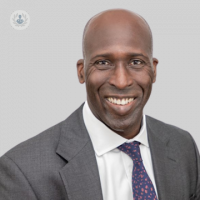Tennis elbow: causes, diagnosis and treatment options
Written in association with:With the approach of summer, many people will be picking up their tennis racquets for the first time for over nine months. In the UK, tennis elbow affects about 1-3 per cent of adults each year, especially those aged 30-50. Leading consultant orthopaedic surgeon Mr Eyiyemi Pearse discusses the causes, diagnosis and treatment options.

What is tennis elbow?
Tennis elbow, also referred to as lateral epicondylitis, is a condition that affects a wide range of individuals, not just tennis players. It occurs when some of the tendons that join the forearm muscles to the outside of the elbow wear out causing pain and tenderness in this region. Although the name suggests a sports injury, tennis elbow can affect anyone who performs repetitive arm, elbow, or wrist movements, particularly if resistance or load is applied when performing these movements. Although patients may experience intermittent acute inflammatory flare ups, the underlying problem is one of wear rather than inflammation.
What are the causes and risk factors?
The primary cause of tennis elbow is overuse. Repeated stresses applied to the forearm muscles can lead to small tears in the tendons. This repetitive strain is often associated with activities such as tennis, hence the name. However, other activities like painting, typing, and even gardening can also contribute to the development of this condition. The degree of damage that occurs to the tendons depends on the size and frequency of the loads applied and the resilience of the tendon which is in part genetically determined. As a result certain occupations can increase the likelihood of developing tennis elbow. It is common in adults between the ages of 30 and 50, particularly those engaged in repetitive manual tasks.
What are the symptoms to look out for?
The principal symptom of tennis elbow is pain and tenderness on the outer part of the elbow. This pain can extend into the forearm and wrist, making it difficult to perform simple tasks such as gripping objects or shaking hands. The discomfort may start gradually but can become more intense over time. Activities that involve lifting, gripping, or twisting the forearm often exacerbate the pain.
How is tennis elbow diagnosed?
Diagnosing tennis elbow typically involves a physical examination. Individuals experience pain when pressure is applied to the affected area and when holding the wrist up against resistance. In some cases, imaging tests such as an X-ray or MRI might be recommended to rule out other conditions that could be causing the pain.
What are the treatment options?
Treatment for tennis elbow focuses on relieving pain and improving the resilience and efficiency of the muscle-tendon unit. Initial recommendations often include rest and avoiding activities that exacerbate the symptoms. Ice packs applied to the affected area can help reduce any acute inflammation and pain. Non-steroidal anti-inflammatory drugs (NSAIDs), such as ibuprofen, may also be advised to alleviate discomfort.
Physical therapy plays a crucial role in the treatment plan. Specific exercises can improve the resilience of the tendon and the efficiency of the muscle-tendon unit. A brace or strap can reduce tendon strain and improve symptoms during activities.
For persistent cases, more advanced treatments might be considered. Each of these has pros and cons and ideally should be discussed with a surgeon who has expert knowledge of all available options. With appropriate management, surgery is rarely required.
Is there anything that can be done to prevent tennis elbow?
Preventing tennis elbow involves addressing the risk factors associated with repetitive motions. Ensure that your equipment and technique in sports or manual tasks is correct, and consider working with a coach or professional if necessary. Regularly stretching and strengthening your forearm muscles can also help prevent the onset of symptoms. If your job involves repetitive movements, take frequent breaks and use ergonomic tools to reduce strain on your tendons.
By understanding the causes, symptoms, and treatment options for tennis elbow, patients can take proactive steps towards managing and preventing this common condition. If you suspect you have tennis elbow, consult with an orthopaedic specialist to receive a proper diagnosis and tailored treatment plan.
If you would like to book a consultation with Mr Pearse, visit his Top Doctors profile today.


